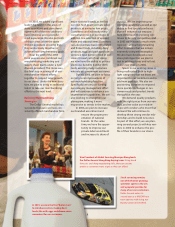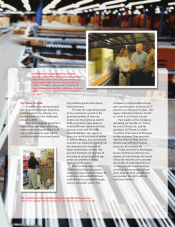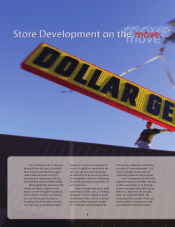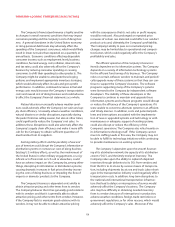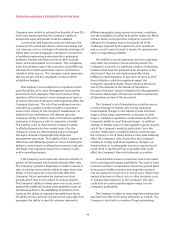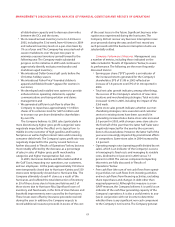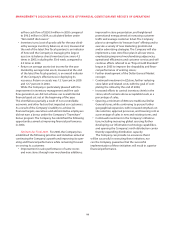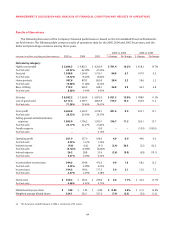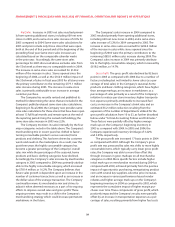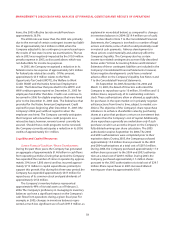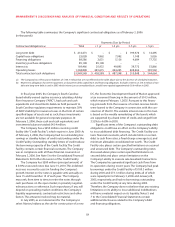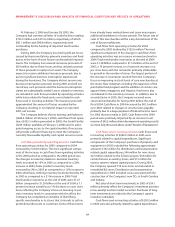Dollar General 2005 Annual Report Download - page 18
Download and view the complete annual report
Please find page 18 of the 2005 Dollar General annual report below. You can navigate through the pages in the report by either clicking on the pages listed below, or by using the keyword search tool below to find specific information within the annual report.
14
FORWARD-LOOKING STATEMENTS/RISK FACTORS
Company were unable to achieve functionality of new DCs
in the time frame expected, the Company’s ability to
achieve the expected growth could be inhibited.
Construction and expansion projects relating to the
Company’s DCs entail risks which could cause delays and
cost overruns, such as: shortages of materials; shortages of
skilled labor or work stoppages; unforeseen construction,
scheduling, engineering, environmental or geological
problems; weather interference; fires or other casualty
losses; and unanticipated cost increases. The completion
dates and ultimate costs of these projects could differ sig-
nificantly from initial expectations due to construction-
related or other reasons. The Company cannot guarantee
that any project will be completed on time or within
established budgets.
The Company’s success depends to a significant extent
upon the abilities of its senior management team and the
performance of its employees.The loss of services of key
members of the Company’s senior management team or
of certain other key employees could negatively affect the
Company’s business. The risk of key employee turnover
intensifies as a greater number of public corporations
locate in the vicinity of the Company’s headquarters. In
addition, future performance will depend upon the
Company’s ability to attract, retain and motivate qualified
employees to keep pace with its expansion schedule.
The inability to do so may limit the Company’s ability
to effectively penetrate new market areas. Also, the
Company’s stores are decentralized and are managed
through a network of geographically dispersed
management personnel. The inability of the Company to
effectively and efficiently operate its stores, including the
ability to control losses resulting from inventory and cash
shrinkage, may negatively impact the Company’s sales
and/or operating margins.
If the Company cannot open new stores on schedule, its
growth will be impeded which would adversely affect sales.
The Company’s growth is dependent on both increases in
sales in existing stores and the ability to open new stores.
Delays in store openings could adversely affect the
Company’s future operations by slowing new store
growth, which may in turn reduce its revenue growth.
The Company’s ability to timely open new stores and to
expand into additional market areas depends in part on
the following factors: the availability of attractive store
locations; the ability to negotiate favorable lease terms;
the ability to hire and train new personnel, especially store
managers; the ability to identify customer demand in
different geographic areas; general economic conditions;
and the availability of sufficient funds for expansion. Many
of these factors are beyond the Company’s control. In
addition, the Company may not anticipate all of the
challenges imposed by the expansion of its operations
and, as a result, may not meet its targets for opening new
stores or expanding profitably.
The inability to execute operating initiatives could nega-
tively affect the Company’s future operating results. The
Company is involved in a significant number of operating
initiatives that have the potential to be disruptive in the
short term if they are not implemented effectively.
Ineffective implementation or execution of some or all of
these initiatives could also negatively impact the
Company’s operating results. Please reference the discus-
sion of the initiatives in the “Results of Operations –
Executive Overview”section included in the Management’s
Discussion and Analysis of Financial Condition and Results
of Operations section of this document.
The Company’s cost of doing business could increase as
a result of changes in federal, state or local regulations.
Unanticipated changes in the federal or state minimum
wage or living wage requirements or changes in other
wage or workplace regulations could adversely affect the
Company’s ability to meet financial targets. In addition,
changes in federal, state or local regulations governing the
sale of the Company’s products, particularly “over-the-
counter” medications or health products, could increase
the Company’s cost of doing business and could adversely
affect the Company’s sales results. Also, the Company’s
inability to comply with these regulatory changes in a
timely fashion or to adequately execute a required recall
could result in significant fines or penalties that could
affect the Company’s financial statements as a whole.
Unanticipated increases in insurance costs or loss experi-
ence could negatively impact profitability. The costs of some
insurance (workers’ compensation insurance, general liabil-
ity insurance, health insurance and property insurance)
and loss experience have risen in recent years. Higher than
expected increases in these costs or other insurance costs
or unexpected escalations in the Company’s loss rates
could have an unanticipated negative impact on the
Company’s profitability.
The Company is subject to certain legal proceedings that
may adversely affect its financial statements as a whole. The
Company is involved in a number of legal proceedings,



